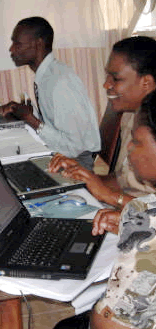

What are the roles of student and facilitator in PBL?
Student: PBL uses a group learning approach. As a member of a learning team you are expected to prepare for the team sessions and contribute actively to the discussions. You will build your knowledge by exchanging ideas, listening to one another, respecting each other’s viewpoints, being critical and asking questions that challenge and probe the issues.
But you will also work independently and engage with the learning resources and do the assessment activities. One of your first tasks is to prepare a learning plan so that you know what you have to learn and how you will learn it. An important aspect of being a self directed learner is to keep an eye on your progress and know when to ask for assistance from your peers and your facilitator when you get stuck. It is up to you to develop the habit of reflecting critically on your own learning in order to improve your learning ability. Managing your own learning includes managing the use of your time so that you are able to pace yourself and complete all your learning and assessment activities.
Facilitator: In this programme a facilitator means someone who is able to guide and support you to play an active role in the learning process and to take responsibility for your own learning. So what exactly is the difference between teaching and facilitating? The key difference is the degree of autonomy. In teaching the teacher assumes full control of the learning process, whereas in facilitation the learner is enabled to take control of her or his own learning. It remains the facilitator’s responsibility though to manage the overall learning process.
A good facilitator knows when to step in and offer support and when not. For learners who are new to PBL facilitators will provide quite a bit of structured support. But as learners and their teams become more used to the PBL approach, the support will probably be less directive. Throughout the PBL process, the facilitator will continue to challenge the teams by asking probing questions.

Orientation
-----------------------------------
1. What is PBL?
2. Benefits of PBL
3. PBL steps
4. PBL roles
5. Assessment strategy
6. What is a portfolio?
7. What is in the portfolio?
8. Assessment criteria
9. Portfolio guidelines
-----------------------------------
Open as a Word Document